So many kids on my caseload are working on following directions. I’m always trying to think of directions for them to follow, and sometimes it's hard to think of them on the spot! I decided to create a resource that would be fun and engaging as well as cater to kids at different levels.
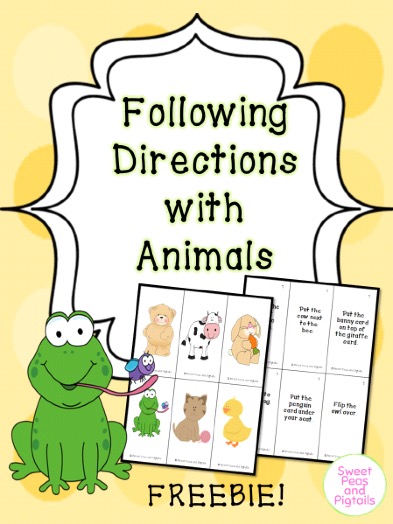
My Following Directions with Animals includes 48 animal-themed following directions! There are 12 animal cards, 12 1-step direction cards, 12 2-step direction cards, 6 temporal (before/after) direction cards, and 6 conditional direction cards.
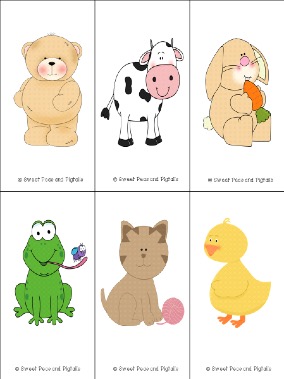
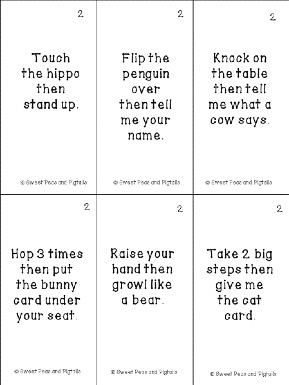
Print, cut, and laminate all cards. Lay the animal cards out in front of the student and give them a direction to follow based on their skill level (1-step, 2-step, temporal, conditional). Re-position animal cards before moving on to the next direction. Each direction card is labeled in the top right corner with either a 1 (1-step), 2 (2-step), T (temporal), and C (conditional) so you can keep the cards organized.
This download includes:
-12 animal cards
-12 1-step direction cards
-12 2-step direction cards
-6 temporal (before/after) direction cards
-6 conditional direction cards
Looking for more following directions activities? Check out my Following Directions Blog where your kids can follow directions through all four seasons!
It’s not officially winter yet, but I’ve been using my winter-themed materials for a few weeks already now. Something super easy I’ve added to my winter stash is cotton balls. The kids get a kick out of calling them “snowballs” and it just puts a new twist on any activity. Read below to find out how I use cotton balls in speech.
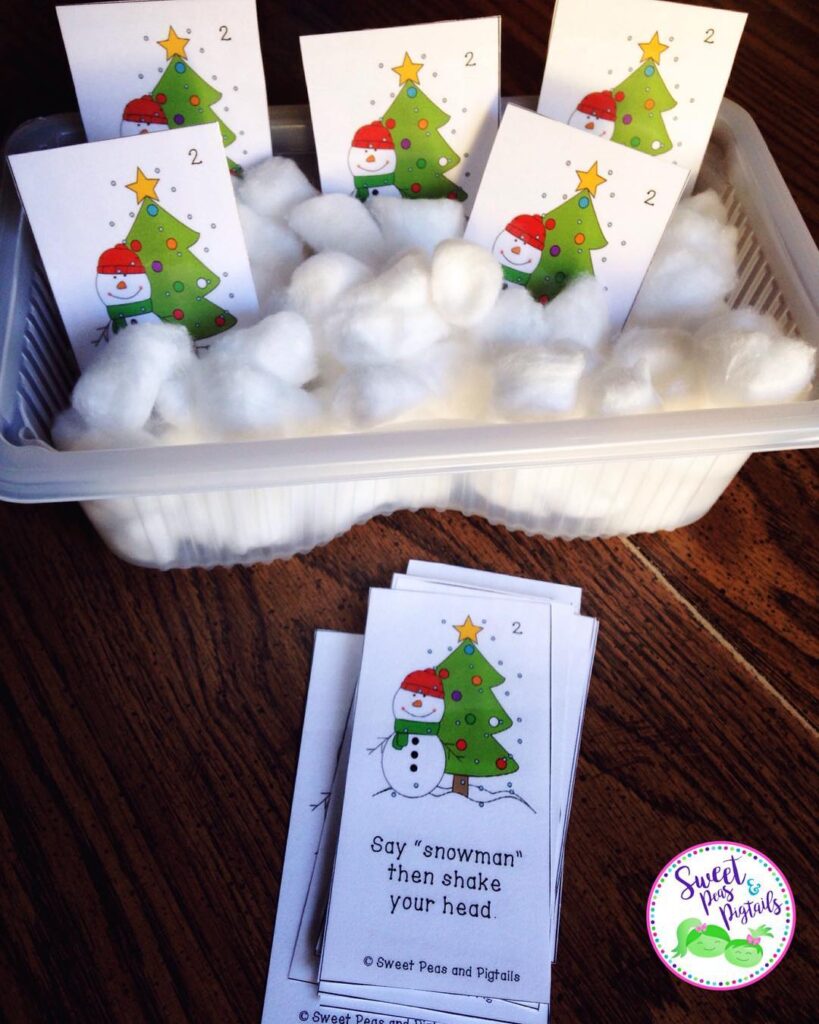
Super, super easy activity! Grab a bin and a ton of cotton balls and hide some cards you’re working on in the bin. In this picture, I put my Christmas-themed following directions cards into the bin and the students picked one card at a time and followed the command on the card. So fun!
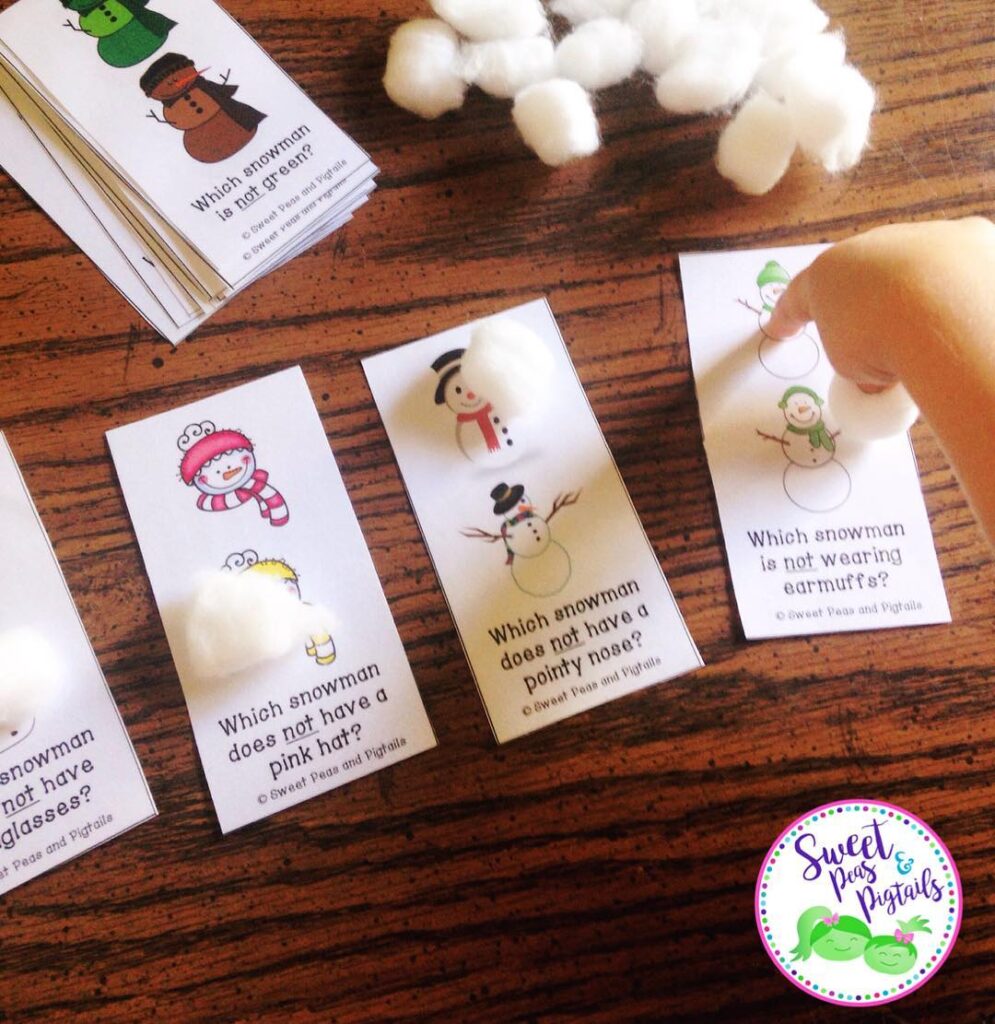
For this particular activity, I used my Snowman Negation flash cards and had the students put a “snowball” on their answer. I usually use the ever so popular dry-erase marker for this activity, but the kids loved the new twist of the cotton balls and were really engaged! I’ve also used the cotton balls as Bingo chips as well.
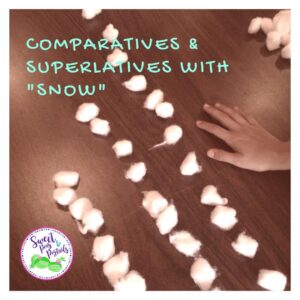
Talk about easy therapy activity! In this picture, the student was working on tall/taller/tallest. We also used our “snowballs” for big/bigger/biggest, long/longer/longest, short/shorter/shortest, etc.
How do you use cotton balls in therapy? I’d love to hear some new ideas! You really can’t go wrong with them!
I love winter-themed materials, especially ones with snowmen. I live in Florida and we need all the winter we can get because it doesn't get very cold here! I've never built a snowman and only seen snow once in my life, and that was at 18 years old! So give me all the snowman materials!
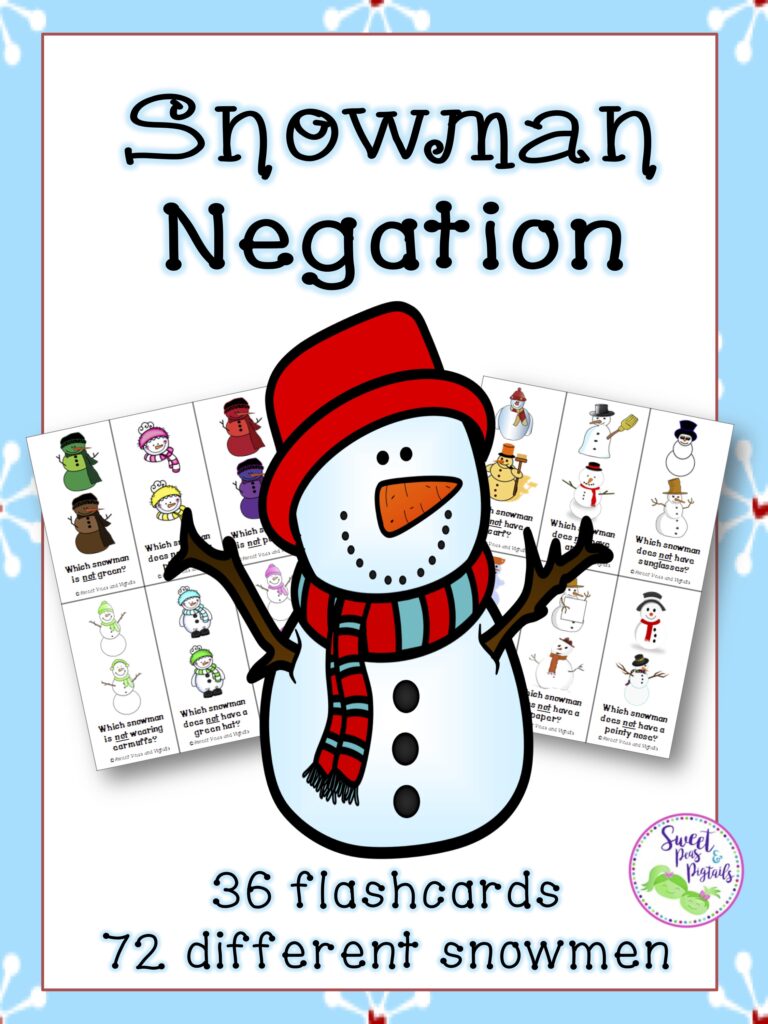
This particular resource targets the concept of negation. I use these flashcards to teach and informally assess negation. I have my students read the question on each card then point to the answer or use a dry erase marker to circle the correct answer once the cards are laminated! Another twist is to have them cover their answer with cotton balls, or “snowballs!” Now, that is a big hit with the kids!
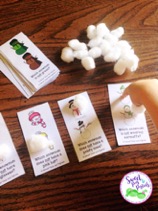
So what do you get with this packet? There are 36 total flashcards with 2 snowmen per card and all 72 snowmen are different! And they are pretty adorable too. 😉
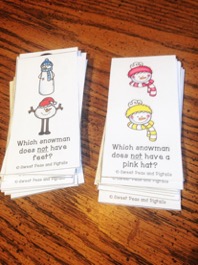
Click here to check out Snowman Negation.
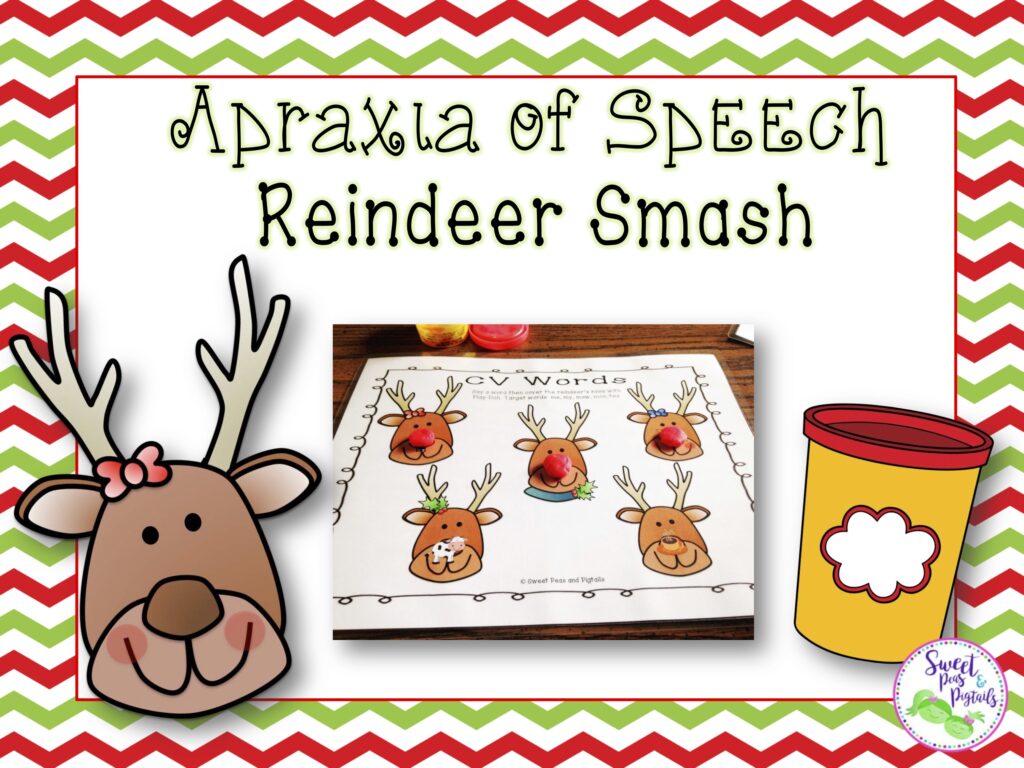
I can’t believe Christmas is less than a month away! It’s still about 80 degrees here in Central Florida, and I’m trying to get in the Christmas spirit by pulling out all of my Christmas and winter-themed products since it just doesn’t feel much like Christmas outside!
Creating Christmas products also puts me in a festive mood. My gumball smash mats have been such a hit with my kids that I decided to create another smash mat product! These reindeer mats have been so engaging for my little friends. There are 29 smash mats included in this packet, with 5 words per mat focusing on the following word shapes:
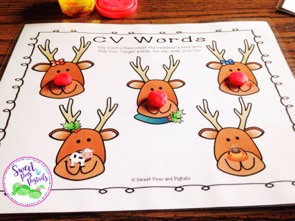
Laminate each smash mat. Choose a word, say it 5 times, and then cover the reindeer’s nose with Play-Doh! So fun! Continue until all pictures have been covered. An alternate to Play-Doh would be covering the pictures with game chips or using the magnetic chips with the magic wand. 😊
Click here to check out Apraxia of Speech Reindeer Smash.
Updated September 23, 2023
I don’t know about you, but I’m always looking for fun ways to work on answering WH-questions in my speech therapy sessions.
Enter gumball smash mats. I’m telling you; these mats have been SO engaging for my little friends who are working on this goal of answering questions! I mean, how cute are those little Play-Doh gumballs?!
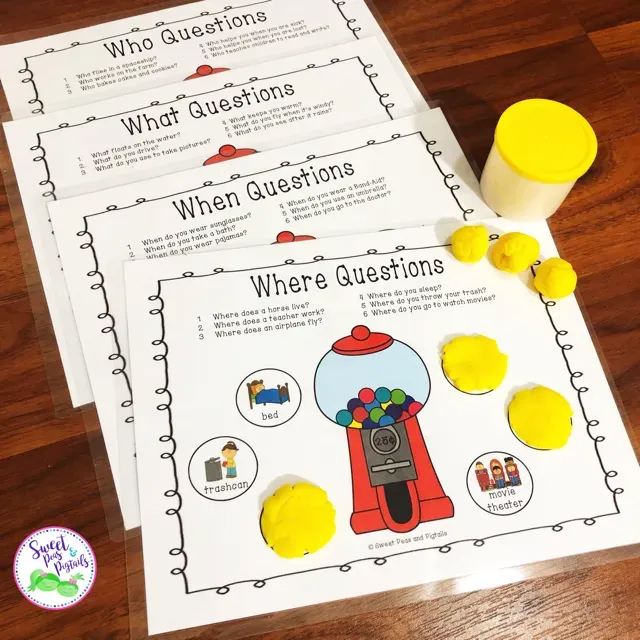
I created these smash mats with preschoolers in mind. I take them to daycares and preschools and I also use them in the clinic with my three- and four-year-old students. And of course, I’ve used them with some of my early elementary aged kiddos as well.
There are 10 smash mats included in this packet, with 6 questions per mat:
This packet includes 10 total smash mats with 6 questions per mat:
I like to laminate each smash mat for durability. Ask your child one of the questions listed and then have your child cover the answer with a Play-Doh “gumball”! Change up the color Play-Doh if you’re brave and want multiple gumball colors. 😉 I’m not that brave!
Continue until all pictures have been covered. I tend to mix up the order that I ask the question each session so the kids don’t get used to a pattern.
If you don’t have Play-Doh on hand, use the magnetic chips with the magic wand or use pom poms. I think that those kind of look like gumballs too! 😊
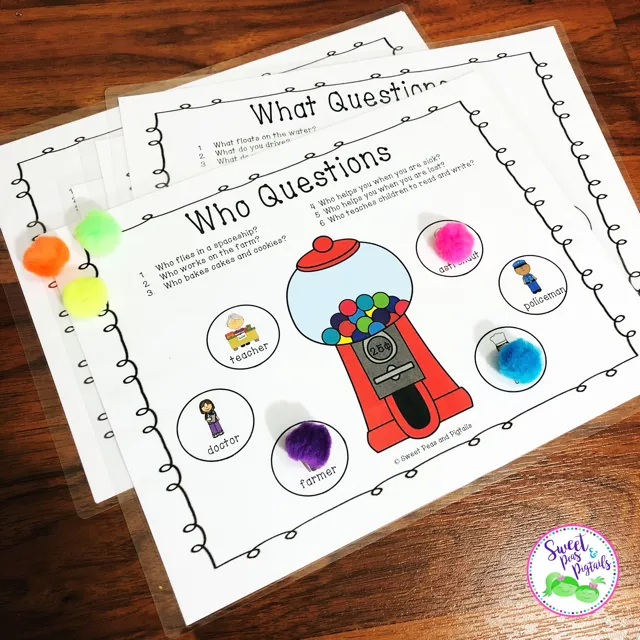
Click here to check out WH-Questions Smash Mats. I hope you find them helpful!
This money saving bundle of following directions activities will keep your students engaged all year long!
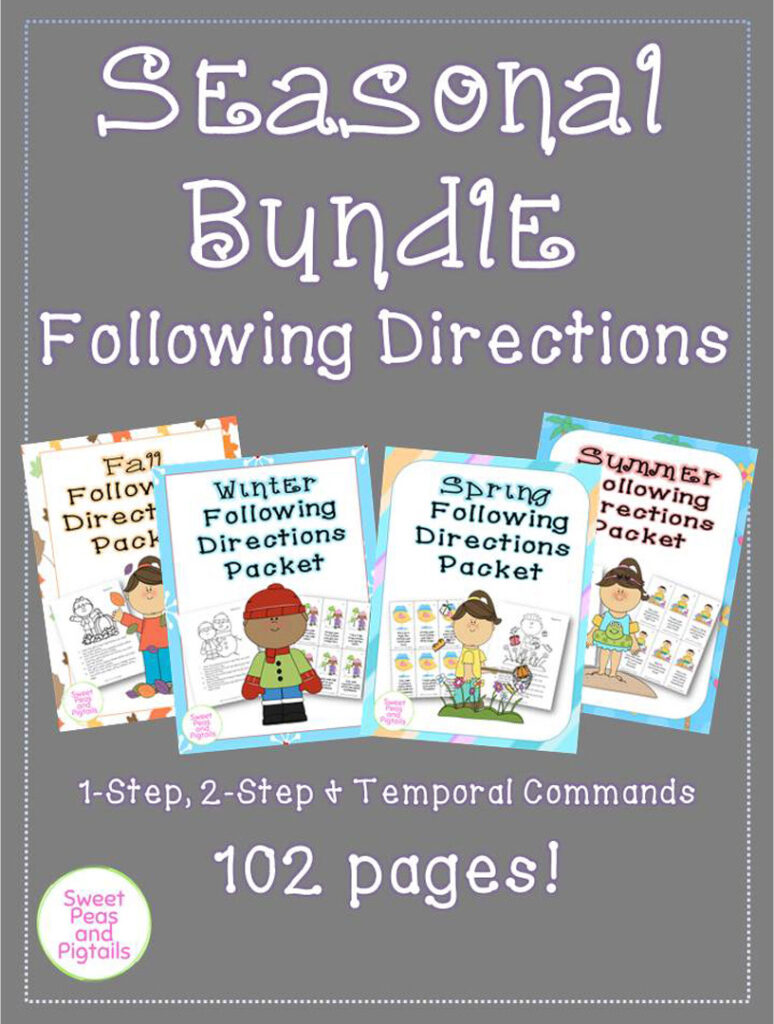
This bundle includes four of my seasonal following directions products (Fall, Winter, Spring, and Summer). Here is what you get for each season:
-54 themed direction cards (18 temporal-before/after, 18 2-step, & 18 1-step)
-15 themed directions coloring sheets (5 temporal-before/after, 5 2-step, & 5 1-step)
Each card and coloring sheet is labeled in the top right corner with the specific direction type so you can keep everything organized.
“Great packet for working on following directions...thanks!”
“Love these following directions activities.”
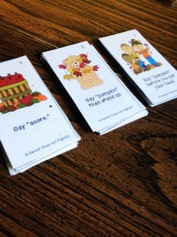
Fall Directions Cards
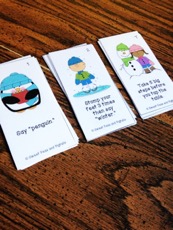
Winter Directions Cards
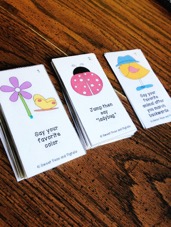
Spring Directions Cards
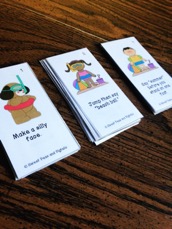
Summer Directions Cards
“Great material that I will be able to use with a wide variety of students.”
“Awesome bundle!”
The bundle also includes coloring sheets! Have your students color the pages during the session or send them home for homework! I like to bind all of the coloring sheets together and make copies as needed.
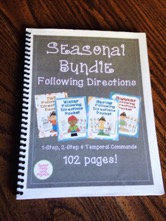
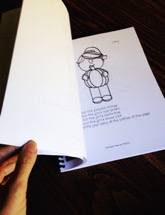
Fall Coloring Sheets
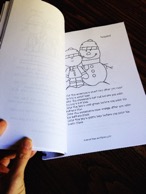
Winter Coloring Sheets
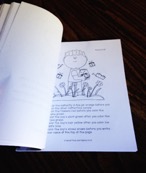
Spring Coloring Sheets
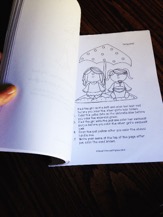
Summer Coloring Sheets
Click here to buy Seasonal Bundle of Following Directions
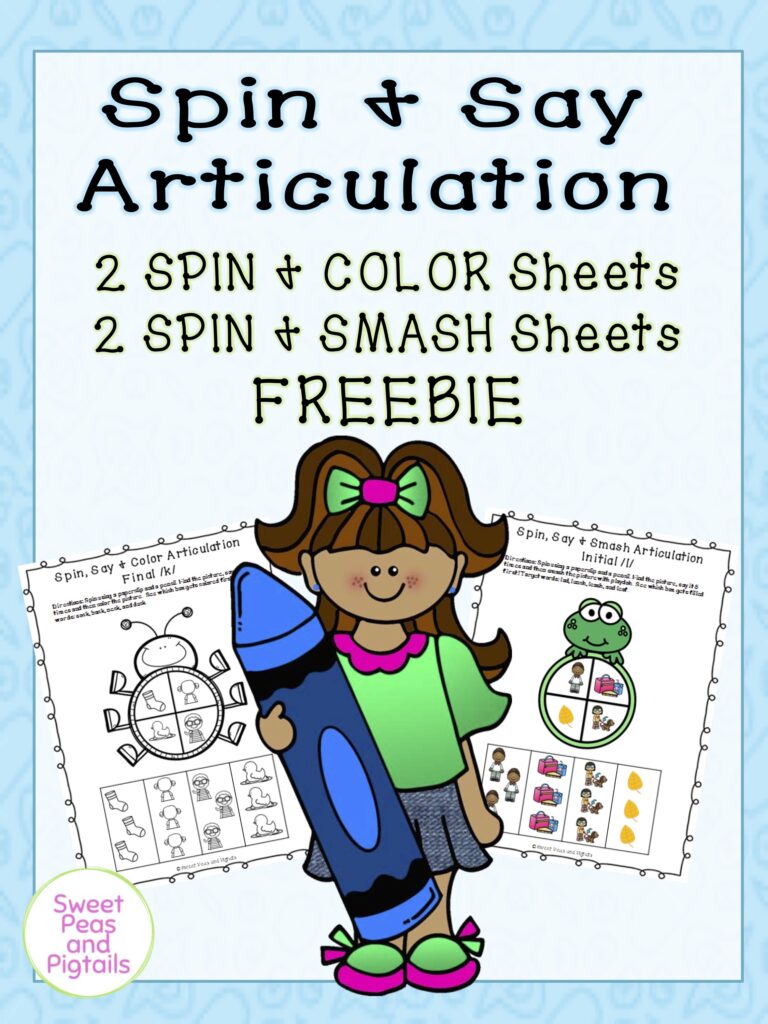
This fun freebie is a sample version of my Spin & Say Articulation {Coloring Sheets & Smash Mats} which contains these pages plus 112 other pages for a total of 58 Spin & Color Sheets and 58 Spin & Smash Sheets! This packet is perfect for the entire school year! I’m constantly grabbing these sheets during my sessions.
Each sheet includes game spinners with 4 articulation target sounds on each spinner. The huge packet includes 18 different sounds! Sounds included are as follows:
Spin using a paperclip and a pencil. Find the picture, say it 5 times and then color the picture. Continue until all pictures have been colored. These coloring sheets are also great to send home for homework!
Laminate colored pages. Spin using a paperclip and a pencil. Find the picture, say it 5 times and then smash the picture with PlayDoh (or cover with a chip). Continue until all pictures have been smashed (or covered).
This packet includes a sample of the huge packet. You get 2 black and white pages and
2 colored smash mat pages for the following sounds (a total of 4 pages):
Click here to receive your FREE resource!
This download includes:
To see more images included in the full version, please click here.
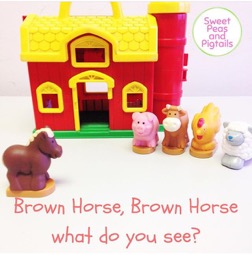
I absolutely love the classic “Brown Bear, Brown Bear, What Do You See?” It’s such a good therapy tool for targeting many different goals including colors, asking/answering questions, turn taking, and vocabulary. My speech kiddos absolutely love this book as do my own children at home!
As I was planning one of my therapy sessions recently, the toy farm animals caught my eye. I thought that it might be fun to modify Brown Bear a little to help this little one with some of her goals. I spread out the animals on the table and gave her the brown horse. We sang, “Brown Horse, Brown Horse, What Do You See? I see a ______ looking at me,” filling in the blank with a farm animal such as “pink pig” or “yellow duck.” This was such a hit with my little preschool friend. She absolutely loved singing along and asking questions, putting the animals in the barn and taking them out (prepositions), and answering yes/no and WH questions (what does a cow say?). We also targeted some of her articulation goals (/f/ in “farm” and ending sounds on words).
This activity was so engaging and one of our best sessions! You really can’t go wrong with farm animals. What are some fun play-based activities your preschoolers like?
I absolutely love the game Hedbanz, and it’s always a hit with my kiddos. If you are unfamiliar with the game, the guesser wears a headband on their head with a card on top. They quickly ask “yes” or “no” questions to figure out what is on their card before time runs out. Those rules alone make for a great game to have around in your speech therapy room!
I recently changed the rules up a little during one of my sessions. I took the articulation cards we were working on, shuffled them, and slid them one at a time into the headband. The other person/people (therapist, other children in your group) describes the picture to the child with the headband. So for “thirsty,” we said, “not hungry but ____.” It was great for opposites, vocabulary, and of course our sound because as soon as they guessed the word, they had to say it five times. The kids loved the variation and didn’t want to stop playing! Speech therapist win!
I also modified the rules another way for one of my kids who struggles with selective mutism. I wore the headband, and placed a card in the slot. I proceeded to ask her “yes” or “no” questions to figure out what was on the card. Once I found out what was on the card, I had her say the initial sound of the word so for “cake,” she had to say /k/. We have had so much success with this activity with this particular child!
How do you use Hedbanz in your speech therapy sessions? I’d love to get some fun, new ideas!
I grew up playing with bubbles and babysat children who loved bubbles. It wasn’t until I became a speech pathologist 11 years ago that I really began to see just how amazing blowing bubbles were at promoting speech and language skills! I use bubbles in therapy all. the. time. And not those bubble machines, although those are pretty fun. I’m talking about the good, ol’ fashioned bubble containers with the wands. They can be used inside or outside and taken on the go, they’re affordable, and not to mention super fun and engaging! I haven’t met a child who does not like them. Read on to find out how blowing bubbles can boost your child’s speech and language development.
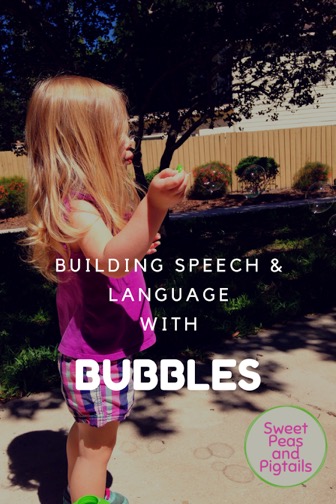
How do I use bubbles for requesting? During my therapy sessions, I often give my kiddos a choice of two or three activities. If they choose bubbles, depending on their level, they must provide some sort of gesture (sign for “bubbles” or “more”), sound (/b/), syllable (“buh), word (“bubble”), phrase (“more bubble” or “want bubble”) or sentence (“I want bubbles”) to receive the bubbles. For example, if I’m working with a toddler who does not have many words, I may have them start to sign the word bubbles. I then would give the child the bubbles for a few turns and then I’d close the container and start the process again.
When a child needs to work on the /p/, /b/, or /m/ sound, I pull out the bubbles. Why? These are bilabial sounds, or sounds made with the lips. There are so many words with these sounds that we can teach while blowing bubbles: “pop,” “bubble,” “up,” “more,” “open,” “dip,” “me,” “bye,” “big,” “blow,” and “please.” Working on these words also teaches them new vocabulary, which leads me to my next point.
If you need to increase your kiddo’s vocabulary, try bubbles! In addition to the words I mentioned above, you can teach them “all done,” “stop,” “close,” “lid,” “catch,” “go,” “on,” “off,” “wet,” “in,” “out,” “fly,” and the list can go on and on! If you have a toddler who is starting to use phrases and sentences, use some of these words together and comment about the bubbles as you play with them: “That’s a big bubble!” “It popped on my head!” “I am wet!” “I caught the bubble!”
Have a child on your caseload who does not make eye contact? Maybe your toddler or preschooler at home struggles with eye contact. Bring out the bubbles! Isn’t it crazy that something as simple as blowing bubbles can promote eye contact?! Make sure you are face to face with your child and begin blowing the bubbles. Wait for your child to make eye contact before you blow the bubbles again.
Blowing bubbles is a simple way to work on turn taking. Take turns with your child blowing and popping the bubbles saying “my turn” and “your turn.” This is something I’m working on at home with my two-year-old!
Bubbles are great communication temptations. I like to get those big colorful bubble containers and put them up high somewhere where the kids will notice them but can’t reach them. At home, I have them on top of our refrigerator in our garage. Because the child can’t reach them, they need to use gestures or words to get the bubbles. When you get the bubbles, hand it to your child. Sometimes the lid is hard to open so they may again have to use gestures or words or maybe even eye contact for you to open the lid.
Blowing bubbles is great for teaching children how to round their lips for the /w/, /o/, and oo. Watch to see if they are rounding their lips when they blow. If they have difficulty with this, gently use your hands and place their cheeks/lips in the correct position. When I notice difficulty with this task, we also try to say more words such as “wet,” “want,” and “more” to encourage lip rounding.
Did you know that blowing bubbles can strengthen your child’s abdominal muscles? This is important for increasing sentence length and sustaining speech. When targeting breath support, I often instruct the child to take a big breath and blow a long stream of bubbles. The kids love it and we turn it into a game trying to blow a longer stream than the last one.
Well there ya have it! That’s how I like to use bubbles to promote speech and language skills with my kids! How do you use bubbles in therapy or at home with your children?